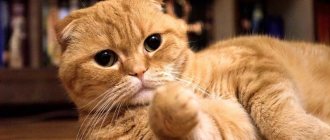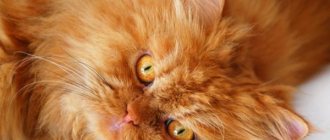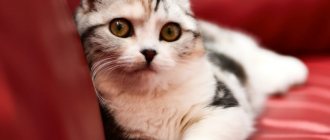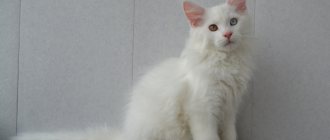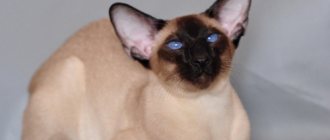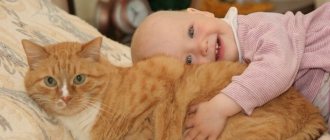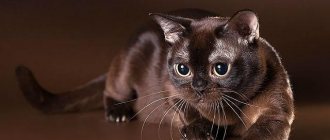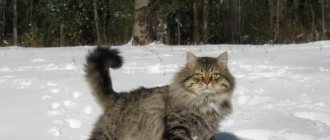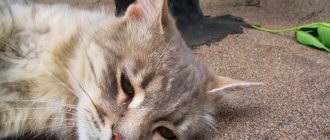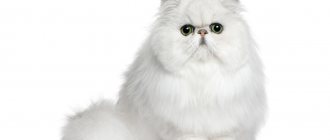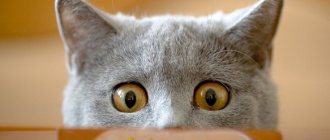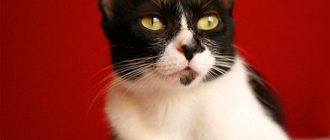Ginger cats in the home have long been considered a symbol of happiness, prosperity and joy. These creatures represent sunlight and warmth. A special gene is responsible for the appearance of a red tint, which is not always inherited. Despite this, red color is not uncommon, so those who want to have a “sunny” cat have plenty to choose from. Ginger cats and male cats can be of different colors and breeds. In nature, there are no monochromatic ginger cats; the color of the animal is always patterned or interspersed. It is believed that all red-haired representatives have a similar character.
There are several breeds of red cats: Maine Coon, red Persians, Karelian Bobtail, American Curl, Napoleon, Somali cat, Ural Rex, Caracal, Turkish Van, Siberian cat, red British.
Red cats of the breed: Photos and names - purebred + Videos from cat breeders
Ginger cats in the home have long been considered a symbol of happiness, prosperity and joy. These creatures represent sunlight and warmth. A special gene is responsible for the appearance of a red tint, which is not always inherited. Despite this, red color is not uncommon, so those who want to have a “sunny” cat have plenty to choose from. Ginger cats and male cats can be of different colors and breeds.
In nature, there are no monochromatic ginger cats; the color of the animal is always patterned or interspersed. It is believed that all red-haired representatives have a similar character. There are several breeds of red cats: Maine Coon, red Persians, Karelian Bobtail, American Curl, Napoleon, Somali cat, Ural Rex, Caracal, Turkish Van, Siberian cat, red British.
Color and deafness
Many white cats are deaf due to inner ear degeneration. Geneticists studying these animals have determined that their deafness depends on eye color:
- 17-22% with eyes of any color except blue;
- about 40% are heterochromic (i.e. with different colors);
- 65-85% with blue eyes.
In cats with different eyes, hearing loss is usually observed on the side of the blue eye.
Kao-mani with blue eyes
The cause of deafness is in the dominant W gene. After much research, scientists have determined that it is pleiotropic - it is responsible for a number of traits in the genotype - not only for coat color, but also for deafness and blue-eyedness. By the way, you can also read about blue-eyed cats and breeds on our portal.
The dominant W allele disrupts the migration of melanoblasts—pigment producers and transporters—and also affects the activity of other cells in the area of the neural tube of the embryo
Deaf cats are excluded from the breeding program. And as a pet, they can live as absolutely full-fledged individuals; the lack of hearing is compensated by other senses. True, such animals will not survive on the street.
Maine Coon
Red cats of the Maine Coon breed are one of the favorites of tailed cat lovers. Representatives of the breed are impressive in size, but retain playfulness, energy and mobility, remaining kittens at heart until old age.
Note: they get along well with people, are friendly, kind and affectionate, a great option for families with children. But they behave warily towards strangers.
Due to its resemblance to the raccoon and lynx, the cat was nicknamed the Maine coon cat. The Maine Coon can come in a variety of colors. Representatives of this cat breed mature within 4 years and can be born with polydactyly - a large number of fingers.
They prefer good premium food and the necessary care.
Red Persians
These fluffy beauties are considered a symbol of wealth and social significance. The breed stands out from the rest by the characteristic structure of its muzzle, on which the depressed nose is in line with the eyes. The pride of the Persian cat is its beautiful coat. Cats are characterized by calmness, balance and silence. They try not to let the owner out of sight at the same time, without annoying them with their meowing.
Representatives of the breed love to communicate with children and adults, walk, and ride public transport.
Note: Not the best breed for catching rodents.
Requires special attention: sometimes you need to wipe your eyes and put in drops; The wool needs to be brushed for 15-20 minutes a day. Representatives of this breed often experience breathing problems.
The most popular breeds of white cats
Turkish Angora
In their homeland, cats are considered special animals and can even be present at prayers. In honor of cats with heterochromia. According to legend, the Prophet Muhammad had different eyes. White Angoras are very elegant, they have soft amber, greenish or blue eyes, delicate and soft hair and a well-furred tail, shaped like an ostrich feather. It is considered a property of Turkey, although it is known that the breed has African roots. At one time, Angoras were on the verge of extinction, but in 1917 they were taken under protection. Curious and friendly cats that retain their playfulness into old age. They get along well with other animals, but prefer to relax alone.
British cat
For representatives of this breed, white color is considered rare. The standard determines that the color must be even, tan marks and haze are not allowed. The cat's eyes are blue or orange, less often of different colors. This breed is considered natural, although other breeds have been added to improve aesthetic qualities: Chartreux, Scottish, Russian Blue. These pets have a well-developed undercoat, the fur is soft and plush. They are quite self-sufficient and independent; they will not impose their company on a person, although they will not refuse to play together. Aggression is not typical for them; they tolerate loneliness well.
Cornish Rex
The highlight of this breed is its curly coat. Cornish Rexes are considered a hypoallergenic breed because they do not have guard hairs. Practically not subject to shedding. White Cornish Rexes look very elegant, they have blue or golden eyes, and a soft pink nose and paw pads. Cornish Rex cats are very smart, people-oriented, and do not tolerate loneliness well. They have an affectionate and cheerful character and love children. The breed was bred by chance; such an interesting coat is the result of a rare gene mutation. To prevent inbreeding, pets were crossed with domestic and Siamese cats.
Khao Mani
Thailand is considered the birthplace of this breed; these snow-white beauties have a huge pedigree. Also, this species is often called “diamond eye”, they owe this name to their blue eyes. Animals with heterochromia are common. They have a soft and dense coat without a pronounced undercoat. The nose and pads are pale pink. The character of the Kao-Mani is reminiscent of the Siamese: they are gentle and kind pets, but they will not allow themselves to be offended. These are born hunters who, when coexisting with other animals, try to take a leadership position. They are easy to train, but can be stubborn. The active development of the breed began in the 90s of the last century, when several cats were exported to the USA.
Siberian cat
White cats with pure color are very rare. This is a natural (aboriginal breed) that was formed without human influence. White Siberians have bright blue or green eyes, the nose and pads are pigmented pink. Long soft coat with a well-developed undercoat, the hair feels denser than that of the Angora. Siberians are subtle psychologists, they behave very reservedly, but they keenly feel if something happens to the owner, they will always be there. Excellent hunters, have high intelligence. Quite large animals that can easily walk on a leash or in the yard. They love outdoor games and are partial to water.
Foreign White
This breed is the result of the deliberate actions of a person who pursued a specific goal: to breed a Siamese cat of a pure white color, without characteristic points. The breed was bred in Great Britain in the 60s of the last century. The second name of the species is Chinese white. The pets have soft short fur and blue almond-shaped eyes. The nose and paw pads are soft pink. They are highly intelligent breeds, love attention, and get along well with children and other animals. They are quite independent, love to walk, and can be easily leash trained. Foreign Whites have an interesting voice with dozens of tones.
Devon Rex
This funny cat looks like an alien with big ears and eyes, but in character it is a gentle and devoted animal. White cats have soft, thin fur, blue or green eyes, and most often have pink pads and nose. There may be wool tassels on the ears. One of the hypoallergenic breeds. The Devon Rex is native to Great Britain. They have a wonderful character; breeders jokingly call Devon Rex “catdog”, because the animal can be taught some commands and accustomed to a leash. They love human company very much and get along with other animals.
Maine Coon
A huge raccoon cat with snow-white fur looks simply gorgeous. According to the standard, only pure shade is allowed, without any inclusions. Maine Coons have golden or green eyes; individuals with blue irises are less common. The nose and pads are usually pink. A characteristic feature of the breed is cute tufts on the ears and thick coat. The birthplace of the breed is the USA. This is one of the largest breeds of domestic cats. Adapted even to harsh winters. The appearance of the Maine Coon speaks for itself: such pets know their worth, they are unobtrusive, but at the same time they prefer not to let their owner out of sight. They love to lead over other animals. An interesting feature of such cats is their voice; Maine Coons have very expressive and varied intonations.
Persian cats
According to the standard, the color of the fur of such a cat should be snow-white, without a yellowish tint. The eyes are blue or dark orange, the nose and pads are pink. Persians have very fluffy and thick fur, which requires careful care. Overall, this is an interesting and friendly breed, one of the oldest in the world. It is not for nothing that they are considered “couch” cats; such cats do not live on the street, preferring human society. They were domesticated a long time ago, but became widespread only in the 70s of the last century. A characteristic feature is a wide small nose; due to the natural characteristics of the partitions, Persians snore and snore funny. The cat's character is friendly and sweet. Pets are human-oriented and friendly, get along well with other animals.
Scottish fold
Curls can have a solid white color; smoky spots or individual hairs are not allowed. The coat should be shiny; kittens may have bluish markings at birth, which later disappear. The pads and nose of Scottish cats are pink, the shade of the eyes is allowed golden or blue. Pets have soft plush fur and ears with a characteristic curve. The breed began to be bred in the 60s of the last century, this is the result of a random mutation. These are typical sofa cats that love warmth and comfort. Quite independent, a characteristic feature is a “creaky” voice. They get along well with children and other animals, love to play, but most often behave independently.
White cats symbolize peace and light; they will not only become guardians of the hearth, but also the most devoted and loving pets!
Karelian Bobtail
The Karelian-Finnish cat, or Karelian bobtail, is a rare breed of small-sized aboriginal Russian cats. It is distinguished by a pleasant character and a tail resembling a pom-pom measuring 4-13 cm. It was the tail that gave rise to the name of the breed with the word “bobtail”.
Karelian bobtails are affectionate, friendly, kind, sympathetic, and treat children's games and guests well. There is no importunity or rancor in them, and animals just don’t like to meow. Karelians get along well with all pets and love to catch rodents.
They have excellent health and do not require special care. In our country, this breed is almost impossible to find, as it is rare and on the verge of extinction.
Note: they are very touchy if they are pointedly offended.
White cat with black spots
Cats differ from other animals in an incredible variety of colors. In many ways, this diversity is due to both the large number of breeds and the careful selection carried out by breeders to obtain increasingly rare colors of pets. Absolutely any cat has its own certain mysteries and secrets, uniqueness and peculiarity. For example, pure white is simply magical. A white cat with black spots occupies a special place among snow-white pets.
Cat colors
Ancient Egypt is considered the homeland of the domestic cat, because it was here that animals were the embodiment of purity and goodness, and were even classified as saints. The man himself worshiped the kitty and was next to her absolutely always. With the advent of the era of travel and the conquest of new lands, domestic cats spread across the globe along with the wandering Phoenicians.
These animals were especially popular in the Mediterranean. Local travelers and wanderers always took cats with them, and they chose exclusively black ones. It is this dark murka that is a unique hunter on a ship, because at night it is practically invisible, and the cat catches mice very deftly and quickly, given that the rodents went out to get the sailors’ supplies precisely in the dark. So the black kitty became simply necessary, and its grandiose triumph continued until the middle of the centuries.
It was at this time that the persecution of witches and magicians began in Europe, and the dark-colored murka acquired the face of a devilish animal, bringing misfortune and failure.
Important! On St. John's Day, once a year, demonstration executions and burning of witches along with their cats were held in city squares. Only those animals that were completely black in color fell under such a cruel ritual. If a black cat with white spots lived in
American Curl
This breed was registered at the end of the twentieth century. A distinctive feature of Curls is their folded back ears. The bend of the ears can be 90-180 degrees.
Animals of this breed have excellent health and a wonderful disposition. She loves interacting with children and gets along well with other pets.
American Curls are prone to obesity, so you should carefully monitor their diet. They are easy to care for, so they are perfect as pets for single men.
Note: when cleaning curls' ears, do not bend or turn the ears in the opposite direction.
History of the Norwegian Forest Cat breed
Norwegian Forest Cat
As you can guess from the name (in different dialects of the Norwegian language, “forest” sounds differently, so there are two options in use - Norsk skogkatt or Norsk skaukatt), these fluffy beauties come from the Scandinavian forests. Scientists today do not have accurate data on how long they live next to humans. The hypothesis is very popular that the countdown dates back to the 16th century, when Angora cats arrived in Western Europe from Ankara. The harsh climate of the peninsula and the need to climb trees a lot led to the appearance of undercoat, strengthening of the claws and the formation of an athletic physique.
However, we cannot completely discount the possibility that, under the influence of external factors in the new environment, the Angora mutation responsible for the length of the coat occurred and became established in Felis silvestris grampia, regardless of its Mediterranean relatives. And those same wild Scottish cats were brought to the territory of modern Norway by the Vikings, who colonized the Shetland, Orkney and Hebrides islands back in the 9th-10th centuries. This version is supported by the traditional image of the leader of the Valkyries, the goddess of fertility, love and war, Freya - the ancient sagas depict her in a chariot drawn by two cats, whose bushy tails are clearly reminiscent of our today's heroes.
In the 19th and first half of the 20th centuries, many Norwegian and Swedish families kept these cats as pets. In the 1930s, after their triumphant appearance at an international exhibition in Germany, serious work began on the phenotype of the breed, the goal of which was to preserve the best natural qualities and weed out undesirable traits. But with the outbreak of World War II, this had to be forgotten, and in the second half of the 40s, the very existence of the Norwegians was threatened due to spontaneous crossing with other cats. The situation was brought under control only by the efforts of enthusiasts. A special committee was created that gave permission for breeding only to those owners whose animals met the standard. The efforts of the Norwegian Association of Pedigree Cat Fanciers were rewarded: King Olav V recognized Skogkatts as the official breed of the country, and in 1977 Pans Truls received the coveted registration with the International Cat Federation (FIFe). By the way, it was he, together with Pippa Skogpuss, who is considered the founder of the modern breed. Born from their union, Pans Silver became the father of 12 litters at once and today is mentioned in almost every pedigree of a purebred Norwegian.
World recognition gave breeders the right to draw up international pedigrees. At the same time, the export of Norwegian forest cats abroad began. Now most of these pets live in Sweden, but other European countries are not far behind. In the USA, local Maine Coons (which, by the way, some are inclined to consider as descendants of the Norwegians) are too serious competition for guests from overseas to speak of real popularity. In Russia, among large breeds, Siberians are still numerically superior, although specialized nurseries have already been opened in Moscow, St. Petersburg, Novosibirsk, Vladivostok and some other cities.
Napoleon
This breed got its name due to the small height and weight of the animal. Everyone knows that Napoleon was short. The color of this breed can be very diverse: red, peach, white, gray. There are two varieties of the breed: classic, with long legs, and extreme, with short legs.
Representatives of this breed are very peaceful and get along well with other pets. They require increased attention and often suffer from loneliness.
Note: Napoleons are very patient with small children and may well become their friend.
Somali cat
The richness of the colors is what amazes you when you first look at this breed. The red color takes on various shades - from light cream to deep red. The Somali cat is distinguished from other breeds by a light frill on the neck and black tips of the hair.
Animals are suitable for those people who are rarely at home because they can easily tolerate loneliness. But first, the kitten must be provided with a variety of toys, otherwise, out of boredom, it will spoil everything it gets into its teeth.
Somalis tolerate water well and love to swim and play in the water. Cats of this breed are very jealous, but treat other pets well. They love to move and hone their hunting skills.
The Somali cat does not need special care, only the oral cavity is susceptible to infection, so it is worth cleaning it regularly.
Ural rex
This is an aboriginal breed of cat, spotted in the Urals in the pre-war years. Its distinctive feature is its curly coat, which naturally forms into graceful curls. Curly-haired cats are few in number and not as popular as Persians or Maine Coons.
Ural rexes are smart, affectionate and silent, they love to spend time with children and adults, and sleep with their owners. They remain loyal to their owner, while calmly treating strangers.
Caracal
This is a wild cat breed that lives mainly in the deserts of Asia and Africa. Caracals are more adapted to living in natural conditions: they swim well and climb trees.
It is not recommended to keep this breed at home. Caracals are beautiful large predators with high immunity, so they rarely get sick. It is recommended to feed with protein foods: fish, meat, eggs.
Note: Caracals should not be fed pork.
Turkish van
Turkish cats are one of the oldest breeds, as confirmed by recent genetic studies. Their main feature is their love of bathing and swimming.
The coat of Turkish Vans is waterproof, soft to the touch, and has the ability to change depending on the habitat the cat is in. In summer, the coat becomes harsher and shorter than in winter.
This breed is also distinguished by its naturalness, naivety and tenderness.
Siberian cat
Back in the 16th-17th centuries, Siberian cats were found throughout almost the entire territory of the Russian Empire, including Siberia. The harsh climate with frosty winds and snow contributed to the appearance of long hair in animals, protecting them from the cold.
By nature, furry pets are friendly and affectionate. Animals of this breed love children, are sociable and neat. They get along well with pets, but do not tolerate rodents. Siberian cats are easy to care for: just brush them and add vitamins to their food.
White cat with black spots
Cats differ from other animals in an incredible variety of colors. In many ways, this diversity is due to both the large number of breeds and the careful selection carried out by breeders to obtain increasingly rare colors of pets. Absolutely any cat has its own certain mysteries and secrets, uniqueness and peculiarity. For example, pure white is simply magical. A white cat with black spots occupies a special place among snow-white pets.
Cat colors
Ancient Egypt is considered the homeland of the domestic cat, because it was here that animals were the embodiment of purity and goodness, and were even classified as saints. The man himself worshiped the kitty and was next to her absolutely always. With the advent of the era of travel and the conquest of new lands, domestic cats spread across the globe along with the wandering Phoenicians.
These animals were especially popular in the Mediterranean. Local travelers and wanderers always took cats with them, and they chose exclusively black ones. It is this dark murka that is a unique hunter on a ship, because at night it is practically invisible, and the cat catches mice very deftly and quickly, given that the rodents went out to get the sailors’ supplies precisely in the dark. So the black kitty became simply necessary, and its grandiose triumph continued until the middle of the centuries.
It was at this time that the persecution of witches and magicians began in Europe, and the dark-colored murka acquired the face of a devilish animal, bringing misfortune and failure.
Important! On St. John's Day, once a year, demonstration executions and burning of witches along with their cats were held in city squares. Only those animals that were completely black in color fell under such a cruel ritual. If a black cat with white spots lived in
Kotovasiya Online magazine about pets
British cats
According to legend, the ancestor of the British was the Cheshire Cat. This breed is distinguished by its sensitivity and intelligence. British cats show independence in behavior and do not like to be held and can be aggressive. There are many color options and red is very common.
Note: British people can be alone for a long time.
Animals of this breed have a large build and good immunity. However, they are prone to obesity, so you need to make sure that your pet is actively moving and does not overeat.
Source
How can you interpret a dream about a white cat?
A white cat, like any predator with teeth and claws, in a dream symbolizes a threat directed at the dreamer or irritation that he will feel in reality.
The dream interpretation of a white cat - why a white cat is dreamed of - reflects the observations of generations, mostly negative. Whether to believe that an animal appeared in a dream to warn about future problems, or to look for a rational explanation for the dream - everyone decides for himself. Our article will discuss the interpretation of dreams about cats with white fur.
What good does it bode?
When a cat in a dream lies on its back with its paws raised up, the dream can be interpreted as an impending victory over its enemies. The animal's pose resembles the raised arms of a defeated enemy.
If in your dream you are trying to catch a white cat, then in reality expect to meet a person with extraordinary thinking.
Basically, dream books interpret dreams about white cats in a positive way, in the case when the animal does not have direct contact with a person: does not sit in the arms, does not caress, does not attack. When the kitty violates the permitted boundaries and impudently climbs onto his knees, or even worse, scratches and bites, the dream can promise happiness to the dreamer if he chased away the cat, hit or even killed it, defending himself from its claws. This outcome of the dream promises that in reality the person will cope with all problems.
A number of dream books contain a positive prediction regarding direct contact with a white kitten - if you pick up a newborn kitten in a dream, this promises great luck.
White and treacherous
According to most dream books, a white cat symbolizes aggression and portends troubles. A cute and fluffy kitty is a collective image of all man’s enemies, scoundrels and flatterers who surround him. Moreover, a snow-white creature with an innocent look
Features of ginger cats
Felinologists call the red coat color red. This color is found in different breeds, but it cannot be called the calling card of any of them.
The color of the coat is determined by the black pigment gene. The red pigment gene is responsible for the red color. It is interesting that among felines, mostly cats have red fur coats. In addition, a mandatory attribute of the red color is the tabby pattern. There are no monochromatic fire coats in nature. Stripes, spots, marble patterns are often combined with white and black colors.
At birth, kittens receive one chromosome each from their mother and father. Females have two sets of colors - on the “X” chromosome (XX), and males - on the “X” and “Y” chromosomes. If the parent pair has the red pigment gene, then the entire litter will be red.
If the father has the black pigment gene, the mother will give birth to tortoiseshell girls and red-haired boys. If both parents have the gene for black pigment, the offspring will turn out black. If the father is a carrier of the red pigment gene, the litter will contain tortoiseshell cats and black seals.
Tortoiseshell cats - a box with a surprise. A mother of this color gives birth to kittens of any color. Black cats can produce tortoiseshell or black girls, red and black boys. From ginger cats, tortoiseshell and ginger cats, black and ginger cats are born.
Reference. Knowing the color of the parent pair, you can calculate the probability of the appearance of red kittens, taking into account gender.
Character
It seems to non-professionals that coat color has nothing to do with the character, habits, mental abilities and temperament of cats. Experts, in turn, note that ginger cats are distinguished by ingenuity, cunning, audacity, independence and a lively mind. It is the sunny fluffies that are better trained than other felines. They are playful, inquisitive and active.
Orange kittens show increased interest in humans and are distinguished by enviable obedience. Animals with sun-colored fur coats are kind and forgiving towards children. Purrs generously forgive pranks and do not harbor resentment in their hearts.
The character of cats also depends on the breed. Persian beauties are affectionate, soft, and compliant. The British are individualists and snobs. Siberian cats have an easy-going character and a gentle disposition. Abyssinians are curious creatures who love to poke their nose into every corner.
Color options
Other tones that descendants inherit from their ancestors also participate in the formation of coat shades. All attempts by breeders to create a uniform color were unsuccessful. Any red color looks patterned.
- White and tan is the most popular option. The white gene in this color combination is dominant and suppresses the white spotting of solid colors.
- Gray-red appears if one of the parents has the D gene, which is responsible for color intensity. The most spectacular combination is red, white and gray. This color is often found among outbred cats.
- A red tabby or tabby appears as fine lines, a clear outline of the upper and lower eyelids, and an "M" shape on the animal's forehead.
- The red tabby is a very varied and interesting color that looks like a shaded tabby. Contrast comes in different intensities.
- Black and red - tortoiseshell. Its carriers are cats. The color is often found in Persians and Maine Coons.
White is not a color
Theory ALL ARTICLES 14261
Photo: Simply Viola /
What color is the cat in the photo? White with red spots? No. In fact, it's exactly the opposite.
Because white wool color does not exist as such. To substantiate this daring idea, let's turn to cat genetics.
Incredible but true: the basic coat color in cats is determined by only three genes: the black gene, the orange gene and the color saturation gene. Where does all the variety of colors come from, including white?
Let's figure it out.
The main gene that determines coat color is the black gene . A gene works like a switch; it can have from two to several possible states - something like "plus" and "minus", or "on" and "off". Each such condition is called an “allele.” The black gene can only be in one of three states: the black allele, the dark brown allele, and the light brown allele.
The black allele is dominant, meaning that when turned on, it suppresses any other condition of the gene. This allele produces black and black-brown coats. In fact, black is a very dark brown; true black is theoretically impossible.
The dark brown allele is recessive to black but dominant to light brown. That is, when it “collides” with other alleles, it is inferior to black, but suppresses light brown. This allele produces a black to brown coat.
The light brown allele is recessive to both black and dark brown. Forms a color ranging from black to medium brown.
The orange gene has only two possible positions. In the “off” position it does not manifest itself at all. This position is called the absence of orange allele . But in the “on” position - the orange allele - this gene turns black or brown color into red!
And finally, the color saturation gene . It regulates the uniformity of coat color and exists in two positions: “dense” color and “dilute” color.
The “dense” color allele is dominant. When the gene is turned on at this position, the color pigment is distributed evenly throughout each hair, making the coat color deep and pure. The main colors are black, dark brown, medium brown and orange (red).
But the “dilute” color allele does not distribute the pigment evenly, but in microscopic groups surrounded by colorless areas. By diluting the primary colors you get blue, tan, beige and cream.
Believe it or not, all possible combinations of these three genes (black, orange, and saturation) create the eight primary cat fur colors:
- black,
- blue (gray),
- dark brown (chestnut or chocolate),
- lilac (lavender),
- light brown (cinnamon),
- beige (tan, fawn),
- red (red),
- cream.
These eight primary colors can, in turn, be mixed to form various colors and patterns - tabby (striped), spotted, tortoiseshell, chinchilla, etc.
But, as you can see, there is no white color here. Where does it come from?
Special genes are responsible for the appearance of white. color intensity genes and albinism . They do not carry any color information. Rather, they act as a putty, “suppressing” the natural color of the coat. But they do it differently.
The color suppression gene is an inhibitor gene that masks the color and pattern of the coat. The word “inhibitor” comes from the Latin inhibere (to delay) and means a substance that suppresses or delays the course of natural processes. A color inhibitor does not change the color and pattern of the coat, it only suppresses them - completely or partially.
This gene can exist in two states - “on” and “off”. When it is "off", its state is called the "i allele", and it has no effect on the expression of coat color.
But as soon as he “turns on”, everything immediately changes. A dominant mutation of this gene - “allele I” - leads to the appearance of uncolored areas of hair.
Photo: Allen Watkin/CC
This allele can manifest itself to varying degrees. Only short areas at the base of the hair are weakly uncolored - up to a quarter of its length. This color is called smoky. In the middle stage, the hair is bleached up to half, this color is called shaded. When the gene is strongly expressed, the hair loses color at three-quarters of its length. This color is called chinchilla or tipped. One hundred percent expression of the color inhibitor gene leads to the fact that some chinchilla kittens are born completely white. Only the eyes retain the color inherent in the true color of the coat, and can be anything - except pink and blue.
The albinism gene in cats affects the coloration of certain areas of the body and eyes. It can only be in one of five states (alleles):
- solid color - “C”,
- albino (albino) - “c”,
- albino with blue eyes (blue-eyed albino) - “ca”,
- Burmese - “cb”,
- Siamese (Siamese) - “cs”.
Thank God, the dominant state of this gene is the solid color - “C” . In this state, the albinism gene is “turned off.”
The albinism allele “ c” causes a congenital absence of the pigment melanin, which gives color to the skin, hair and iris of the eyes. Such cats, like all albino animals, have white fur and pink eyes. Again, thank God, the “c” allele is recessive to all other alleles and therefore appears very rarely.
The allele for an albino with blue eyes - "ca" - is dominant to the albino allele and recessive to all others. The albinism gene in the “sa” state almost completely suppresses all colors not only of the coat, but also of the eyes. This cat looks almost like a complete albino, with a very pale, barely visible base color and light blue eyes. Surprisingly, the eyes of such cats only appear blue. In fact, they are completely colorless. Read how this happens in the article “Sky blue eyes of Siamese cats.”
The Siamese color allele – “ cs ” - is recessive to the solid color allele, is equivalent to the Burmese and is dominant to the other alleles. The result of its action is moderate albinism, like in Siamese cats. How did you not know that all Siamese cats are albinos? Then read about it here!
The Burmese allele – “cb” – is recessive to the solid color allele, equivalent to the Siamese and dominant to the other alleles. Leads to mild albinism, lightening the black coat color to dark brown. In Burmese cats this color is called sable. The “cb” allele also affects eye color: they become green or golden-green.
The Burmese and Siamese color alleles have the same dominance. This made possible the emergence of the Tonkinese cat breed - from crossing a Siamese cat with a Burmese cat. Tonkinese cats are characterized by a combination of Siamese coat color with greenish-blue (aquamarine) eye color.
Albino cats, contrary to popular belief, are not deaf. Another gene is responsible for the dramatic combination of white color and deafness, which we will discuss below.
The spotting gene is responsible for the presence, size and shape of white spots on the main coat pattern. The gene exists in four alleles: spotless "s", spotted "S", partially spotted "Sp", and Burmese "Sb". The existence of the last two alleles is often questioned - it is very difficult to isolate their manifestation.
The natural (“switched off”) allele is the spotless one – “ s ”. It is recessive, that is, it does not affect dominant color genes and does not form white spots.
Photo: Christine Majul/CC
The spotted allele - " S " - leads to the appearance of white spots on different parts of the body. This allele manifests itself in different ways - from a small white spot in black cats to a completely white color with several colored hairs. Unlike the albinism gene, the white spot gene does not affect eye color.
Now you know that a black and white cat is actually a black cat with white spots. And if a white cat has green or yellow eyes, then this means that the cat has one white spot on its entire body, and it itself is not white!
Photo: hehaden/CC
The Partial Spotted allele - "Sp" - is a variation of the Spotted allele. The classic pattern of such an allele is an inverted white “V” with the apex on the forehead, diverging towards the eyes. The chin, belly and paws may be white. Depending on the severity of this allele, the amount of white may decrease to a white medallion on the chest or a spot on the forehead.
The Burmese allele - "Sb" - is also a variation of the spotted allele, but is highly specific. It got its name in honor of the Burmese cat breed. It is “visible” only on the paws. Cats with this type of white spot gene appear to be wearing white socks. Depending on the degree of manifestation of the “Sb” allele, the amount of white may decrease so that only the “slippers” on the feet remain white.
White gene is the last gene responsible for the suppression of natural color and white coat color. When it is "off" ( the " w " ), coat and eye color are unaffected. But the “turned on” gene— the “W” allele —suppresses the manifestation of the natural coat color until it is completely absent. The same gene changes the color of a cat's eyes to blue or orange. Blue-eyed white cats are often deaf; cats with orange eyes also experience deafness, but less frequently. Often white cats have different eyes - one is blue and the other is orange. Such cats are sometimes deaf in one ear - on the side of the blue eye.
Photo: Cesar Pena/CC
There is also a third state of this gene - the “ Wv allele ”. It is also called the “Van” allele - in honor of the Turkish Van breed. The "Ww" allele creates the classic van pattern: a white cat with colored spots on the top of the head, on the ears and on the tail. The size of the spots depends on the degree of manifestation of the allele's effect. There are only ten such degrees; they are also called levels. The minimum white color is the first level. And at the tenth level - almost completely white wool, with barely noticeable manifestations of color. For example, Seychelles cats have a Van color of the seventh, eighth or ninth level.
So what did we find out?
That, from a genetic point of view, white is not a color, but the result of its suppression by genes responsible for color intensity or albinism. Any color has shades, but only white has no shades. In a sense, white is not a color, but the absence of color. Or this: take any color and reduce its saturation to zero. You will get white even if the original color was supposed to be black, tan or striped.
Source: R. Roger Breton and Nancy J Creek, “Feline Genetics”
the science
Comments ()
Log in to leave a comment
Use your social network account:
GoogleFacebookVkontakteMailruYandex
Top best breeds of red cats
The top most popular breeds of ginger cats are headed by Persians, followed by the British and Scots. Exotics and Bengals are gaining popularity. Purebred Maine Coons attract attention with charming tassels on their ears and long silky fur. In addition, the list of popular breeds includes: Abyssinian and Siberian cats, Kurilian Bobtail, Turkish Van, Cymric, Savannah, Toyger, Somalia.
Persian
When you mention the Persians, your imagination pictures a well-fed, fluffy ginger cat. The red color of representatives of this breed is not too bright, it is rather creamy. Persians are loving and sociable. They easily find a common language with all family members.
The fur is thick, long, soft, and easily tangled. A lush collar adorns the neck, shoulders and chest. Such a fur coat requires careful care, and first of all, daily combing.
British
The British cat is associated with the color blue, but saffron milk caps are also common among representatives of this breed. The sunny shade is very rich and bright, and in combination with plush fur it looks amazing. The breed standard allows for 250 color combinations, but more or less solid colors are preferred.
Sunny Britons have coarser guard hairs, so the animals look larger due to the protruding hairs. The undercoat and guard hairs should be of the same tone without inclusions. The chin, tip of the tail and belly may be lighter.
Scottish lop-eared
The distinctive feature of the Scottish Fold is its round, ball-like head, flattened muzzle and drooping ears. The wool is fluffy, “cloudy”, very soft and pleasant to the touch. There are 1-3 folds on the ears.
Red color is rare. It is considered real luck to have a charming red-haired Scot. There is a pattern on a red background, most often a tabby.
Abyssinian
An intelligent and energetic Abyssinian has a strong and muscular body, long limbs and tail, a long neck, a wedge-shaped head, and large ears. The coat is thin, shiny, and harsh to the touch.
Representatives of this breed are flexible, independent, curious, loyal, and sociable. The red color of the coat is dark, rich, closer to copper, the tips of the guard hairs are dark in color.
Kurilian Bobtail
The Kuril Bobtail is a rare breed native to the Kuril Islands.
There are two varieties - short-haired and long-haired. A distinctive feature of the breed is its short tail. The body is strong and muscular, slightly tilted forward, the paws are large, the head is wedge-shaped, and the eyes are large.
Cats skillfully have a free character. They are affectionate, loving, inquisitive, and quickly become attached to people.
Orange color mixed with white and tabby is quite common.
Exotic
Exot is a close relative of the Persian. The animal has the same flattened muzzle and snub nose, strong build and square body. The coat is short and plush. One of the colors is red.
By nature, exotics are calm and good-natured. They are smart, playful and cheerful.
Siberian
Siberians are brave, loyal cats, born hunters. The animals have luxurious, long hair and a thick double undercoat. The iris of a rich orange-amber color evokes the admiration of connoisseurs of this breed.
The chic fur coat has light stripes and white inserts on the paws and shirtfront.
Maine Coon
The Maine Coon is a bright, presentable cat that resembles a lynx. Despite its serious appearance, it is a peaceful, responsive animal that can get along with all family members.
The most common color is white and red. Depending on the combination of tones, the following types are distinguished:
- bicolor - 50/50 white and red;
- harlequin - several red spots on the body;
- van - red head and ears;
- white tuxedo - against the background of the red color there is a white spot on the chest and white socks on the paws.
Turkish van
The Turkish Van is a semi-longhaired cat without undercoat. Red or chestnut spots with ring inserts at the base of the ears, on the body and tail stand out against the main white background.
Wool does not allow water to pass through, allowing Vans to swim to their heart's content.
Somalia
The Somali cat is a beauty with copper fur. Abyssinian is its closest relative. The Somali has a thick, long coat. The fluffy tail looks especially impressive.
There are dark spots on the head and tail. The iris is bright green. Representatives of the breed are smart, tactful, calm, patient and very sociable.
Breed standard
The World Cat Federation has prescribed the following standard of appearance for Persian cats.
- The squat, large or medium-sized body is supported by low, stable paws. The chest and shoulders should be broad and muscular.
- The thick coat, up to 12 centimeters long, is fine and silky. The neck, shoulders and chest have a collar-shaped coat of fur.
- The not very long fluffy tail is slightly rounded at the end.
- The head is round and massive, of good proportions, with a voluminous skull.
- The forehead should be prominent and the cheeks should be full.
- Persians have a short and wide, slightly snub nose with very open nostrils.
- Strongly built jaws and chin.
- The ears are small, set wide and low on the skull. They should be rounded at the ends, with beautifully growing tufts of hair.
- The eyes are large, very expressive, shiny, round and spaced far apart. Their color depends on the specific coat color (they can be blue, golden and even multi-colored).
- The coat can be either one color or consist of two or three shades.
- The weight of the animals varies from 3 to 7 kg.
Breeds of long-haired red cats
The British cat can be short-haired or long-haired. The second option was obtained by crossing the British with Somalis and Persians. Representatives of the breed look great in white and red color.
The list of long-haired breeds with the red color gene also includes:
- Maine Coon;
- Somalia;
- Persian;
- Scottish lop-eared;
- van;
- exotic;
- angora;
- Siberian cat;
- American Curl;
- Napoleon.
Shorthair
List of shorthaired ginger cats:
- Abyssinian cat;
- Kurilian Bobtail;
- Cymric;
- savannah;
- toyger;
- Bengal;
- wild cat - caracal;
- Ural rex.
Nuances of care
There are no special rules for caring for red cats. When choosing grooming products, owners should focus on the type of coat and its length. To comb long-haired breeds, slicker brushes, fine-tooth combs and stiff brushes are used. For short-haired breeds with a thick undercoat, furminators are suitable, as they perfectly remove dead hairs and do not injure the guard hairs.
Bath days are held no more than once every six months, unless the cat herself doesn’t mind taking a bath. Famous water lovers include Bengals, Maine Coons and Turkish Vans. For example, the Scots and British are terrified of water and hate swimming.
Characteristic diseases
The relationship between coat color and the health of cats has not been established. It is known for certain that animals with a red color are more predisposed to allergic diseases and tolerate anesthesia less well.
Care and nutrition
You need to care for a red and fluffy domestic cat in the same way as a pet of any other color. It is necessary to monitor your pet's diet so that it does not turn into an arrogant fat cat, like the famous cartoon character named Garfield. You will need to take into account the characteristics of the breed and ask the breeders what to feed the Maine Coon or Turkish Van, and also find out in more detail what disease the pet is susceptible to.
Important! According to experts, ginger cats tolerate anesthesia and similar drugs for pain relief less well than others. This fact has not been proven scientifically, but nevertheless it exists
Every pet needs stable and proper nutrition, healthy sleep in a place specially equipped for it, and regular examinations by a veterinarian.
Interesting facts and signs about ginger cats
Red cats often become heroes of films, comics, cartoons, and TV series. The most famous movie characters are the plump red cat Garfield and Puss in Boots from the cartoon “Shrek.” Red-haired beasts made a splash at the Disney film company! This includes Thomas O'Malley from the cartoon "The Aristocats" and the Cheshire Cat from "Alice in Wonderland."
Fans of Audrey Hepburn will remember the red cat in the movie Breakfast at Tiffany's. Potter lovers will not forget Crookshanks, Hermione’s unusual friend (pictured below).
If in ancient times black cats were feared and considered fiends of hell, then red furry cats were revered and called amulets, fearless defenders of the home.
There is an opinion that if a ginger cat takes care of a sick person, it means that recovery will come soon.
They used to believe that if a ginger cat comes into a house, it brings warmth and harmony. A fiery red cat in a person’s home means wealth.
Cats are excellent diagnosticians and healers. They are placed on the sore spot, and after a while the person notices that the pain and discomfort go away.
To improve family relationships, people adopted a sunny kitten.
Reference. Sometimes owners love their pets so much that they bequeath entire fortunes to them. A cat named Blackie is considered the richest cat in the world. The owner bequeathed her 15 million pounds sterling.
There are some signs associated with the behavior of red cats. For example, if an animal greets a guest warily, then most likely the person has bad thoughts.
If the cat does not lag behind the owner and asks to be held, perhaps it feels negative energy and is trying to remove it.
If a ginger cat crosses the owner's path from left to right before a trip, it is better to reschedule plans or delay them for half an hour.
